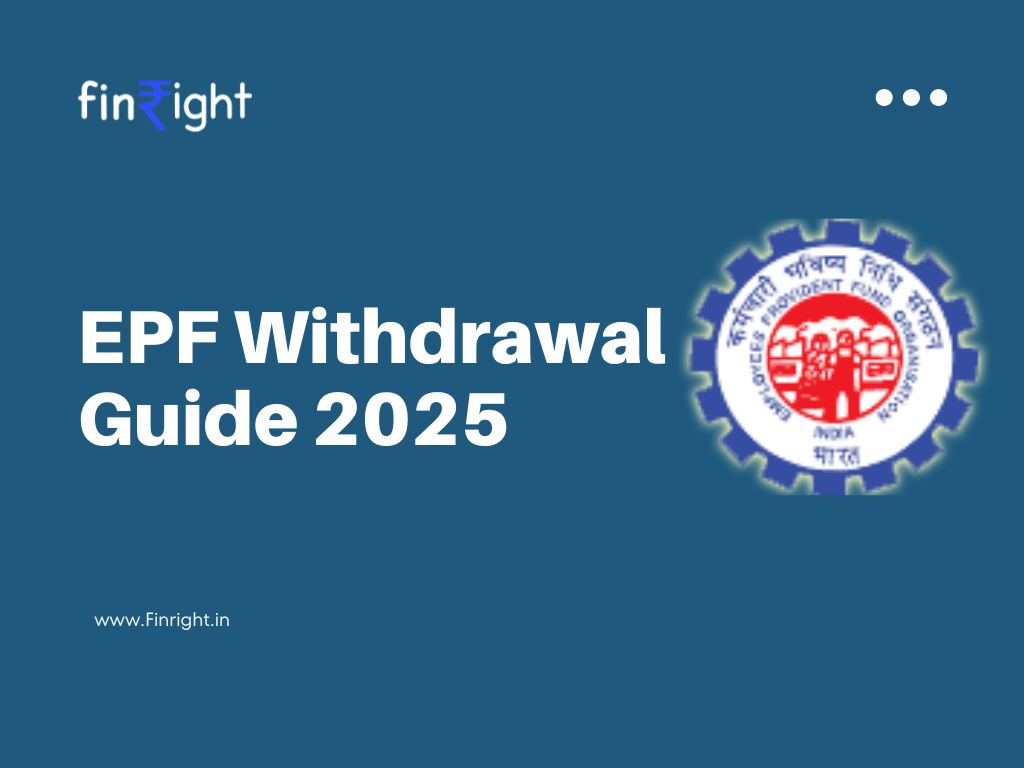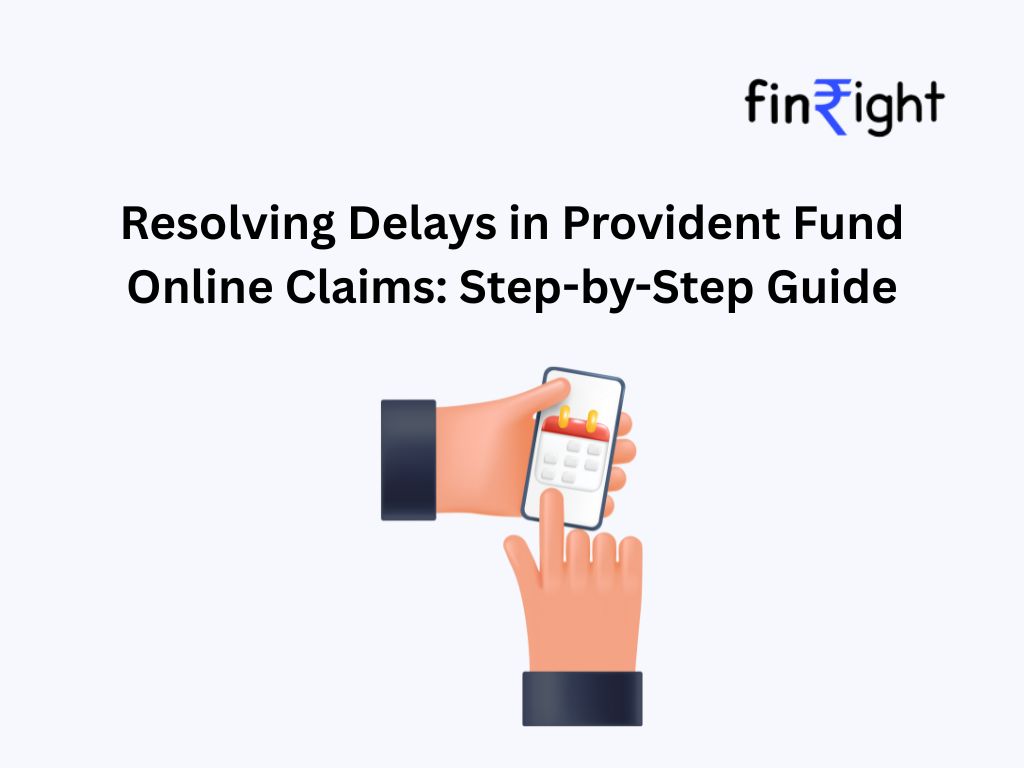Employee Provident Fund is a retirement savings scheme designed to help salaried individuals build a secure corpus over time. It reduces financial stress post-retirement. However, EPF can also act as an emergency fund. Since it is primarily intended for retirement, certain rules and eligibility criteria ensure your savings are protected.Thus, if this condition is met you can withdraw the entire amount. This blog breaks down everything you need to know about EPF withdrawal.
What is EPF?
Employee Provident Fund is a long-term savings scheme where both the employee and employer contribute monthly toward the employee’s retirement fund.
- Contribution: 12% of Basic + Dearness Allowance from both employee and employer.
- Structure of Contributions:
- Employee Share (EPF): 12% from the employee.
- Employer Share (EPF): 3.67% of basic + DA.
- Employer Share (EPS): 8.33% of employer’s share goes to EPS
Withdrawing EPF Amount
EPF withdrawals are categorized into two types:
1. Full and Final Withdrawal
Allowed only under specific conditions:
- Unemployment for more than 2 months.
- Retirement from service.
- Permanent settlement abroad.
2. Partial Withdrawal
Partial withdrawal of EPF balance can be made only under certain reasons. There are limits fixed for each reason, as detailed below:
Medical Purposes
- Limit: Up to 6 times the monthly basic pay, or the available contribution + interest if less than that amount.
- Eligibility : No minimum service requirement.
- Other Conditions: Applicable for treatment of employee, spouse, children, or parents. The wait time for the next claim is a month.
Marriage
- Limit: Up to 50% of the employee’s share of EPF contribution.
- Eligibility : Minimum 7 years.
- Other Conditions: For the marriage of the employee, son, daughter, or sibling. Can be used up to 3 times.
Education
- Limit: Up to 50% of the employee’s share of EPF contribution.
- Eligibility : Minimum 7 years.
- Other Conditions: For the employee’s education or their child’s post-matriculation education.
Purchase of Land or House Construction
- Limit:
- Land: Up to 24 times the monthly basic salary + DA.
- House Construction: Up to 36 times the monthly basic salary + DA.
- Total withdrawal is limited to actual cost.
- Eligibility : Minimum 5 years. Can only be applied once
Home Loan Repayment
- Limit: The minimum of:
- 36 times the monthly basic salary + DA
- Total corpus (employee + employer contribution + interest)
- Total outstanding loan principal and interest
- Eligibility : Minimum 10 years.
House Renovation
- Limit: The minimum of:
- 12 times the monthly basic salary + DA
- Employee’s contribution with interest
- Total cost of renovation
- Eligibility : Minimum 5 years.
- Other Conditions:
- Property must be in the employee’s name or jointly with the spouse.
- Withdrawal allowed twice: once after 5 years and again after 10 years of house completion.
Partial Withdrawal Before Retirement
- Limit: Up to 90% of total accumulated balance with interest.
- Eligibility : Must be at least 54 years old.
- Other Conditions: Allowed within one year before retirement or superannuation.
- Withdrawal allowed: Up to 90% of the total EPF balance.
- Eligibility: Minimum 5 years of service.
- Frequency: Allowed once.
How to Withdraw PF Online
Step 1- Visit the EPF Member Portal
Step 2- Login using your UAN and password.
Step 3- Verify KYC by navigating to ‘Manage’ > ‘KYC’.
Step 4- Click on ‘Online Services’ > ‘Claim (Form-31, 19, 10C & 10D)’.
Step 5- Enter your bank details and click ‘Verify’.
Step 6- Accept the declaration and click ‘Proceed for Online Claim’.
Step 7- Choose your withdrawal type: Full, Partial, or Pension.
Step 8- Enter withdrawal reason, amount, and address.
Step 9- Submit using Aadhaar OTP.
Offline Withdrawal Process
- Download the Composite Claim Form (Aadhaar/Non-Aadhaar) from EPFO.
- Fill the form with required personal and employment details.
- Attach supporting documents like ID proof, cancelled cheque, etc.
- Submit to your regional EPFO office.
- Employer attestation is required if using the non-Aadhaar form.
Required Documents
- UAN (Universal Account Number)
- Aadhaar card
- PAN card
- Bank account details with IFSC
- Cancelled Cheque
- Form 15G/15H (if applicable to avoid TDS)
Taxation on EPF Withdrawal
- No tax if withdrawn after 5 continuous years of service.
- TDS applicable if withdrawn before 5 years:
- 10% if PAN is submitted.
- 30% if PAN is not submitted.
- Submit Form 15G/15H to avoid TDS if eligible.
How Long Does PF Withdrawal Take?
Once your online claim is submitted successfully, it typically takes 3 to 25 working days for the money to be credited. However, delays are common. Claims may get stuck due to technical issues, incomplete KYC, dual UANs, or if your employment details don’t match EPFO records.
According to recent reports, PF claims are processed in an average of 6–10 working days post-verification, but some cases may take longer, especially if the claim is flagged for manual review or if you’ve recently changed jobs.
Why Some People Can’t Withdraw the Full Amount
Even if you believe you’re eligible for 100% withdrawal, there are many reasons your claim may get delayed or rejected:
- Exit date missing or wrongly marked
- Multiple UANs linked to the same Aadhaar
- Pending transfer from old employer
- EPS not consolidated or claim not done via Form 10C/10D
- Not eligible for the same
It’s also important to note that the pension (EPS) part is not fully withdrawable unless you’ve completed less than 10 years of service. If you’ve crossed the 10-year mark, you can only claim monthly pension starting at age 58.
Don’t Get Stuck — Use CheckMyPF to Know What’s Withdrawable
Rather than guessing whether you can withdraw your full PF, use CheckMyPF—an AI enable tool by FinRight that shows:
- Your total PF balance across employers
- Whether 100% withdrawal is possible
- If any amount is blocked or ineligible
- EPS eligibility and pension status
- What forms you need to file and which issues are holding you back
It’s instant, free, and only requires a password if you want to deep dive into the PF account.
Use FixMyPF to understand your eligibility, and take control of your money the smart way.
👉 Click here to check if your PF is withdrawable
Want to know how to transfer your PF funds easily?
Read our step-by-step guide: How to Transfer All Your PF Amount in One Account






Pf amount withdrawal
If you need assistance raise query at Finight.in.
PF amount withdrawal
How we can help you?
PF amount my account withdrawal
How we can help you?
bbala18364@gmail.com
PF amount my account withdrawal
Hi sir raise the request at finright.in
Pf amount withdrawal
How can we help you?